On this page
The Working Group International Waterbird and Wetland ResearchThis page lists reports produced by the Working Group International Waterbird and Wetland Research. The publications are listed by date with the most recent at the top.
|
|
|
|
The Importance of North-Eastern Mongolia for Migrating Pacific Golden Plovers: Spring 2005Jan J. Wijmenga, Joop Jukema, Jeroen Reneerkens, Sundev Gombobataar, B. Gantulga & S. Tserennadmin
WIWO Report 87
Working Group International Waterbird and Wetland Research
2011
"Global population estimates of Pacific Golden Plovers (Pluvialis fulva range from as low as 100,000 to as high as 1,000,000. Earlier reports suggest that between 4,000 and 50,000 Pacific Golden Plovers migrate through the Mongol-Daguur Strictly Protected Area in North-Eastern of Mongolia, which is an important area for numerous breeding and migrating birds. Given these estimates, the Mongol-Daguur Strictly Protected Area may host a significant portion of the world's population during migration. To gain a better understanding of the stopover behaviour of Pacific Golden Plovers, and of the importance of this area for this wader species, a Dutch-Mongolian expedition was set up. During a 16 day period, Pacific Golden Plovers on migration were counted, caught and measured."
|
 |
|
Monitoring and breeding ecology of arctic birds at Medusa Bay, Taimyr, Russia 2005H. Van Kleef, R. Smeets, D. Osipov, K. Tretjakov, T. Kirikova, D. Nowak, A. Nowak & J. Gregersen
WIWO Report 86
Working Group International Waterbird and Wetland Research
2009
"In 2005 an expedition of the Working Group International Waterbird and Wetland Research (WIWO) visited the Medusa Bay area, near Dikson on the Taimyr peninsula, in northern Siberia (Russia), at 73o23'N 80o32'E . The main aim of the expedition was to apply a standardized breeding bird monitoring method intended to reveal temporal changes in breeding bird numbers at Medusa Bay. This will improve our knowledge of population dynamics of waders and other bird species. The main goal of the monitoring programme is to focus on numbers of all bird species present within fixed plots. Furthermore some important demographic variables, being nest success, environmental variables (snow cover, temperature) and biotic variables (lemming and Arctic fox abundance, arthropod availability) are monitored to be able to explain changes in breeding bird numbers and breeding success. Apart from carrying out the monitoring scheme, research activities also included research on breeding ecology of Brent Geese in relation to Snowy Owls, which was a continuation of the research performed in 1999."
|
 |
|
Syrian Sociable Lapwing SurveyRemco Hofland and Guido Keijl
WIWO Report 85
Working Group International Waterbird and Wetland Research
2008
"Until recently, there was scant information on the surviving numbers of Sociable Lapwings, their preferred habitat, migration routes and on the main threats to their survival. The species is currently classified as Critically Endangered by BirdLife International: the world population was estimated to number only 1200 individuals (Delany & Scott 2006). Between 18 February - 5 March 2007 a team consisting of Dutch and Syrian birdwatchers surveyed wetlands and fields in approximately the northern half of Syria on the presence of this species. Here, many hundreds were found. After this date, two team members stayed in the area holding the highest numbers until 26 March, when all Sociable Lapwings had left. Sociable Lapwings were encountered in four natural steppe areas in northern Syria: three situated in the central-northern agricultural area (Eiwa, Al Aumair and Ar Ruweira) and one further south (Al Fedha), between Deir ez-Zor and Palmyra. Altogether, 1579 Sociable Lapwings were counted prior to 5 March, while a week later, on 8-9 March, the highest estimate numbered 2000 birds. None of the birds checked were colour-ringed. Information was collected on numbers, behaviour, plumage and diet. All birds were exclusively seen in natural steppe habitat, except for a small flock that left the steppe to rest in an arable field. No birds were observed near water, with the exception of 12 Sociable Lapwings that briefly stayed near a sabkha (temporary pool) near Eiwa."
|
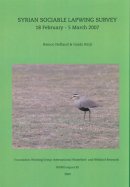 |
|
Waterbirds in coastal wetlands of Sierra Leone, January-February 2005J. van der Winden, A. Siaka, S. Dirksen, M.J.M. Poot
WIWO Report 84
Working Group International Waterbird and Wetland Research
2007
"Coastal wetlands in Sierra Leone were censused for bird numbers during the period January/February 2005: Scarcies Estuary, Sierra Leone River Estuary, Ywri Bay, Turtle Islands and Sherbro Island. In total 94,000 waterbirds were counted and more than 115,000 were estimated to be present in coastal brackish and marine wetlands. Based on the results, all area met the ornithological criteria to be listed as Important Bird Areas (IBA's) or as Wetlands of International Importance (Ramsar Convention). Apart from this, staff of CSSL and WCB were extensively trained in waterbird identification, counting waterbirds and related methods (GPS, analysing techniques). Also, during the trip 11 villages were visited for extensive discussions with local authorities about conservation topics. From these interviews information was collected about the occurrence of other species (groups) e.g. marine turtles, manatees. Also interviews were taken on hunting pressure and willingness to conserve threatened species."
|
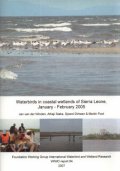 |
|
Waterbird census of coastal Cameroon and Sanaga river, January-March 2007Edito: J.J. Van der Waarde
WIWO Report 83
Working Group International Waterbird and Wetland Research
2007
"A bird survey was carried out from January to March 2007 of the coastal wetlands of Cameroon and the lower Sanaga River. This WIWO report describes the results of this study. The coastal wetlands are described, and for all 66 species of waterbirds present, numbers and estimates for the total coast are presented. The coast of Cameroon is important for Palaearctic waders and Afrotropical waterbirds. Numbers of African Skimmer, Grey Pratincole, Royal Tern and Little Tern exceed the 1% population threshold. Three areas, the Ndian Basin on the Northern coast, the Wouri or Douala estuary and the lower reaches of the Sanaga pass several criteria for the Ramsar Convention and qualify as wetland of international importance. All three areas currently face threats of habitat destruction due to human interventions including oil exploration, hydropower dam construction, industrial developments, clearing of mangroves and overfishing. Conservation actions are recommended, including designation of three areas under the Ramsar Convention and poverty alleviation programs for the population that inhabit these areas."
|
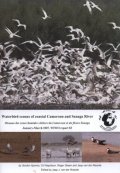 |
|
Waders and waterbirds in the floodplains of the Logone, Cameroon and Chad, February 2000Editor: W. Ganzevles, & J. Bredenbeek
WIWO Report 82
Working Group International Waterbird and Wetland Research
2005
"Since 1991 several ornithological surveys and studies have been carried out in the Waza-Logone floodplain. A total of 346 bird species has been recorded since 1991. The most numerous waterbird species are White Pelican, Squacco Heron, Little Egret, Cattle Egret, Glossy Ibis, White-faced Whistling Duck, Collared Pratincole, Ruff and Black-tailed Godwit. For the resident species Black-crowned Crane the Logone gloodplain is one of the last strongholds. For Collared Pratincole the area is one of the major wintering areas in Africa. Sedge Warbler and Reed Warbler are vvery abundant as well as Barn Swallow. Annual counts of wintering waterbirds in the Lake Chad Basin Area in Cameroon (The Logone river and its floodplain) started in 1993 ans showed the importance of the Logone floodplain for wintering waterbird species. The February 2000 census presented in this report counted nearly 230,000 waterbirds and waders in the floodplains on both sided of the Logone river in Cameroon and chad. Waterbird numbers in the Lake Chad Basin Area have been increasing since 1995, indicating that the floodplain restoration of the Waza-Logone Project has a positive effect on waterbird habitat quality."
|
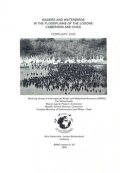 |
|
Wader and waterbird census at the Banc d'Arguin, Mauritania, January 2000E.J.M. Hagemeijer, C.J. Smit, P. de Boer, A.J. van Dijk, N. Ravenscroft, M.W.J. van Roomen & M. Wright
WIWO Report 81
Working Group International Waterbird and Wetland Research
2004
"The Banc d'Arguin is one of the key wintering areas for waders and other waterbirds in the world. Despite its relatively modest size it supports higher numbers of wintering waders than any other site on the East Atlantic Flyway. It holds the highest densities of wintering waders known from Europe and Africa. Since 1973 only 4 more or less complete counts have been carried out in the area during the wintering period of northern birds (in 1979, 1980, 1990-94 and 1997). The more recent counts show that important changes in bird numbers have occurred. These changes, as well as the high international value of the Banc d'Arguin, justify more frequent monitoring. In January 2000 the Parc National Banc d'Arguin has been visited in order to carry out a count of all waders and waterbirds in the area."
|
 |
|
European Swallows Hirundo rustica And Other Songbirds Of Wetlands In Ghana, December 1997S.B. Deuzeman, T.M. van der Have, W.T. de Nobel & B. van den Brink
WIWO Report 80
Working Group International Waterbird and Wetland Research
2004
"With the establishment of long-term breeding bird monitoring schemes in several European countries, it became clear that breeding bird populations are hardly ever stable and may species wintering in Africa, including European Swallows, are declining. Apart from may short-term changes largely caused by variation in the weather, long-term changes are related to changes in land use and intensification of agricultural practices in Europe, and global climate change. Population trends in several species are linked to changes in rainfall patterns in the non-breeding areas in Africa. These relations have been mainly established on correlations between rainfall patterns and population trends, and field data are lacking in many species. This motivated to study European Swallows in Ghana. The field work concentrated on the following topics: searching for concentrations of foraging or roosting Swallows; and catching of Swallows and other wetland-related songbirds with mistnets to collect data on age, biometrics and moult."
|
 |
|
Waterbirds in Lake Orumieh, Iran, September 2000Roland Jalving & René Vos
WIWO Report 79
Working Group International Waterbird and Wetland Research
2003
"Between 13 and 30 September 2000, a waterbird census of Lake Orumieh and bordering marshes was carried out. The fieldwork was done by a team of WIWO (Working Group International Waterbird and Wetland Research, The Netherlands), in good cooperation with the Department of Environment of the Islamic Republic of Iran. The main purpose of the project was to update the information of the value of the wetlands of North-West Iran for migrating waterbirds, since little research has been carried out there after the 1970's. The research area comprised of Lake Orumieh and its surrounding areas, including some rivermouths and marsh areas (Eslamabad wetland) And lake Shorgul and Yadegarlu. Part of this area is designated as National Park. The conditions during the survey were not optimal. Several of the visited wetlands in the area were partly or totally dried up and with low numbers of waterbirds."
|
 |
|
Monitoring and breeding ecology of arctic birds at Medusa bay, Taimyr, Russia, in 2000Raymond H.G. Klaassen, Hans Schekkerman, Ingrid Tulp, Michael Berezin, Andrew G. Bublichenko, Julia N. Bublichenko, Sergei P. Kharinotov, Sofia Rosenfeld & Sergei Khomenko
WIWO Report 78
Working Group International Waterbird and Wetland Research
2003
"In 2000 a WIWO expedition was organised to the remote Taimyr Peninsula, which is situated in the high north of Siberia Russia. Members of this expedition were Sergei Khomenko (Ukraine) and Raymond Klaassen (Netherlands). The expedition was organised in close co-operation with two workers of the Dutch institute 'Alterra' and 5 Russian researchers. We stayed at the convenient Willem Barenz Field station, which is situated 18 km south of Dikson in the Medusa Bay area. The field station was built with financial help from the Dutch Ministry of Agriculture, Nature Management and Fisheries in 1994. From 1996 on WIWO expeditions were carried out to this area (Tulp et al, 1997; Khomenko et al, 1997; Felix & van Turnhout, 2000; Willems & van Kleef, 2000). Aims of this year expedition were continuing of the in 1998 developed standardised bird monitoring program (Van Turnhout et. al, in prep.) and study wader breeding ecology."
|
 |
|
Breeding Birds Of Medusa Bay, Taimyr, Russia. Methods For Biological Monitoring In The Arctic With Results Of 1998 And 1999Frank Willems, Chris van Turnhout, Hein van Kleef & Rob Felix
WIWO Report 77
Working Group International Waterbird and Wetland Research
2002
|
 |
|
Distribution and status of Great Bustards Otis tarda in the Konya Basin, Turkey, spring 2000C. Heunks, E. Heunks, G. Eken & B. Kurt
WIWO Report 76
Working Group International Waterbird and Wetland Research
2002
"The Great Bustard, Otis tarda, is a globally threated species. Information on numbers and distribution in Turkey is scarce. Previous work of DHKD suggested that probably the best area for Great Bustards in Turkey is the converted steppe of the Central Anatolian Plateau. For this reason a Great Bustard survey was carried out in this region, here termed the Konya Basin, in spring 2000. During this survey 83 birds (34 males) were located in four different areas within the Konya Basin. Birds were found on three different display grounds. Habitat descriptions of display grounds do not suggest any exclusive relationship between Great Bustard distribution and habitat, but human activity is substantial in all areas ant there are strong indications that the suitability of display grounds depends on the relative intensity of human activity. Numbers are still significant in this region, but the species is subject to heavy disturbance and the status of these populations is far from secure. Extrapolation of basin-wide numbers is not possible given current data. Additional surveys are recommended to discover new display grounds and to gain an insight into seasonal movemnets by Great Bustard. Conservation action is recommended to safeguard the Turkish Great Bustard population in the near future."
|
 |
|
Waders and waterbirds in the floodplains of the Logone, Cameroon and Chad, January-February 1999A.J. Dijkstra, W. Ganzevles, G.J. Gerritsen & S. de Kort
WIWO Report 75
Working Group International Waterbird and Wetland Research
2002
"For many wader and waterbird species the inland West-African wetlands are of great importance as wintering sites. However the expanding human population caused a tremendously increased pressure on inland wetland resources in the past four decades. Together with a sequence of droughts in West-Africa this diminished, and still threatens, the capacity to support wildlife. Therefore further research should be carried out to extend knowledge and quantify the value of specific inland wetlands, in view of possible protection of the most vulnerable areas in the nearby future."
|
 |
|
Waterbirds in the gulf of Gabès and other wetlands in Tunisia, autumn 1999J.||F.F.P. Bos, G.M. van der Geest, N.L.M. Gilissen, R.A.J. Pahlplatz, I Essetti & F. Ayache
WIWO Report 74
Working Group International Waterbird and Wetland Research
2001
"Between 18 September and 8 October 1999 an ornithological expedition of the Foundation Working Group International Waterbird and Wetland Research (WIWO) was carried out in Tunisia. Aims of the expedition were: to assess the international importance of the Gulf of Gabès for waterbirds in autumn; to assess the international importance of a number of coastal and inland wetlands in other parts of Tunisia for waterbirds in autumn; to develop a procedure for preparing and performing integral counts of waterbirds in Kneiss; to collect sight records of ringed birds and search for Slender-billed Curlews."
|
 |
|
Waterbird count of Zanzibar and Pemba Islands, Tanzania, January 1998Editor: R. Geene
WIWO Report 73
Working Group International Waterbird and Wetland Research
2001
"Between 8 and 28 January 1998, a waterbird census of Zanzibar and Pemba Islands was carried out within the framework of the 1998 Tanzania Waterbird Count. The fieldwork was done by a team of WIWO, cooperating with the Commission for Natural Resources and the Department of Environment on Zanzibar Island and Pemba. The project resulted not only in good results of the bird count itself, but also proved the productiveness of the established international cooperation. It is hoped that the kind of cooperation that could be established will be repeated in the near future. Suggestions for projects on waterbirds in the future could be: setting up a regular monitoring scheme for the most important areas, carrying out a more complete survey on Pemba and trying to estimate fluctuations in the numbers during the period half December to half April by aerial surveys."
|
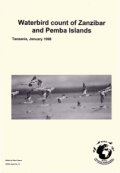 |
|
Searching for Slender-billed Curlews in Iran, January-February 2000T.M. Van der Have, G.O. Keijl, J. Mansoori & V.V. Morozov
WIWO Report 72
Working Group International Waterbird and Wetland Research
2001
"Between 13 January and 3 February 2000 about 20 wetlands were visited to count waterbirds and pay special attention to the presence of Slender-billed Curlew Numenius tenuirostris, a globally threatened species. At least, 1,200 Eurasian Curles N. arquata and 250 Whimbrels N. phaeopus were checked individually, as well as several hundreds of Bartailed Godwits Limosa lapponica and Black-tailed Todwits L. limosa, but no Slender-billed Curlews were observerd."
|
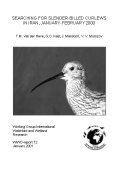 |
|
Counts And Ecology Of Waterbirds In The Sivash, Ukraine, August 1998J. Van der Winden, E.A. Diadecheva, W.T. de Nobel & M.W.J. van Roomen
WIWO Report 71
Working Group International Waterbird and Wetland Research
2001
|
 |
|
Zeist-Nouakchott, 2001O. Overdijk, C. de le Court & A. gueye. Rencensements de Spatules Blanches, Banc d'Arguin, Mauritanie, janvier
WIWO Report 70
Working Group International Waterbird and Wetland Research
2000
|
 |
|
Ecology of Grey Plovers Pluvialis squatarola breeding in the Lena Delta, The Sakha Republic/Yakutia, in 1997K-M. Exo, & O. Stepanova
WIWO Report 69
Working Group International Waterbird and Wetland Research
2000
|
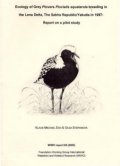 |
|
Oiseaux Nicheurs sur les côtes du Parc National du Delta du Sine-Saloum et du Parc National Langue de Barbarie, Sénégal, 1998Guido O. Keijl, Allix Brenninkmeijer, Frans J. Schepers, Robert E. Brasseur, Abdoulaye Ndiaye, Eric W.M. Stienen & Jan Veen
WIWO Report 68
Working Group International Waterbird and Wetland Research
2000
|
 |
|
Waders and waterfowl in the floodplains of the Logone, Cameroun, January 1993J.C.J. Van Wetten & P. Spierenburg
WIWO Report 67
Working Group International Waterbird and Wetland Research
1998
"The objectives of the Logone 1993 project of WIWO and Ecole de Faune were: providing basic data on waterfowl and migratory wader and waterbirds of the Logone floodplains and the Lake Chad area in North-Cameroun, in the context of the yearly IWRB mid-winter counts of tropical and sub-Sahara wetland areas; gathering relevant data on bird numbers and distribution for priority of conservation and protection measures in North-Cameroun; providing relevant data on the Zero-situation of wader and waterfowl numbers, before large scale floodplain restoration initiatives become implemented in the Waza Logone floodplain area; in-field training of staff members of the Ecole the Faune, Garoua, into methods of bird counts and monitoring; initiating yearly counts of waders and waterbirds by staff and students of "Ecole de Faune", by organising yearly counts by students and staff of the "Ecole de Faune", being an integrated part of the fieldwork in the wetland course of this institute; forming an expertise-pool, especially at the "Ecole de Faune" to be used for the yearly IWRB mid-winter counts in tropical and sub-Sahara Africa in subsequent years. This report concerns methods, results and conclusions of the first two objectives. It discusses the significance of the Logone floodplains and the Lake Chad area for wintering Palearctic waders and waterbirds, as well as Afro-tropical species."
|
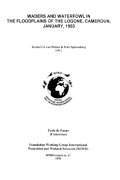 |
|
Birds of Medusa Bay, NW Taimyr, in 1997S. Khomenko, S. Rosenfeld & S. Dyluk
WIWO Report 66
Working Group International Waterbird and Wetland Research
1999
"This report presents the results of a study of breeding waders and other bird species in Medusa Bay, NW Taimyr in 1997. The study is part of a long-term monitoring scheme of the area around the Willem Barentsz Biological Station. The survey was carried out between 17 June and 26 July 1997 and included estimation of breeding bird densities and nesting success, Brent Goose feeding ecology and a survey of the Severo-Vostochnie Islands."
|
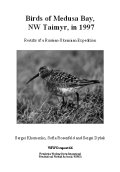 |
|
Surveys Of Flora And Fauna In The Senné Fishpond-Area, Slovakia, Spring 1997A. Wieland
WIWO Report 65
Working Group International Waterbird and Wetland Research
1999
"In order to fill the major gap in our knowledge of the ecological function of the Senné fishponds a study was carried out in spring 1997. This report is a summary of the most important results of this project. It includes descriptions of the Senné fishponds area, the results of the ecological studies, discussions (threats), recommendations to manage the Senné fishponds area and results of ecological studies in August 1998."
|
 |
|
Breeding birds of the Albanian wetlands, spring 1996M.J. Zekhuis & D. Tempelman
WIWO Report 64
Working Group International Waterbird and Wetland Research
1998
|
 |
|
Oiseaux d'eau dans le Delta du Sine-Saloum et la Petite Côte, Sénégal, janvier 1997F.J. Schepers, G.O. Keijl, P.L. Meininger & J.B. Rigoulot
WIWO Report 63
Working Group International Waterbird and Wetland Research
1998
"To get a better view of the international importance of this area, a project was set up by the Working Group International Waterbird & Wetland Research (WIWO) in collaboration with the Direction des Parcs Nationaux du Sénégal (DPNS). The main objectives of the project in the Sine-Saloum Delta were: to count ail waterbirds in wetlands between Dakar and the border with The Gambia, especially the Sine-Saloum Delta; to pay special attention to (colour-rings of) European Spoonbills and Little Terns, their habitat choice, behaviour, etcetera; to describe the various wetlands and their threats; to judge the suitability of wetlands for monitoring purposes; to contribute to the African Waterfowl Census; to co-operate with rangers of the Direction des Parcs Nationaux du Sénégal. The results of this project are presented in this report."
|
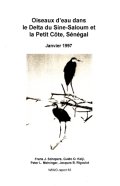 |
|
Waders And Other Waterbirds In The United Arab Emirates, Autumn 1994G.O. Keijl, P.S. Ruiters, T.M. van der Have, A. bij de Vaate, E.C.L. Marteijn & R. Noordhuis
WIWO Report 62
Working Group International Waterbird and Wetland Research
1998
"In autumn 1994 and spring 1995 several coastal wetlands in the United Arab Emirates were surveyed for waders and other waterbirds. In Khor Dubai, a shallow lagoon just east of the city of Dubai, holding high numbers of waders and other waterbirds, a more detailed wader study was carried out. The study focused on Broad-billed Sandpipers, as part of this species' migration route and wintering grounds are still unclear."
|
 |
|
Breeding waders at Cape Sterlegova, northern Taimyr, in 1994I. Tulp, H. Schekkerman, T. Piersma, J. Jukema, P. de Goeij & J. van de Kam
WIWO Report 61
Working Group International Waterbird and Wetland Research
1998
"In the summer of 1994 a Dutch/Russian expedition was undertaken to Cape Sterlegova in northern Taimyr. The expedition period lasted from 10 June until 12 August. Our special interest concerned the energetics of breeding in the high arctic. We studied the cost of incubation (doubly-labelled water method) and nest incubation schedules (by means of radio-tracking) in Knots. After hatching, the energetic of growth in Knot chicks were studied. Other studies undertaken included: monitoring of breeding bird densities in a 12 km2 study area, recording breeding success of waders, recording seasonal abundance of arthropod fauna, trapping and ringing of adult waders."
|
 |
|
Ecological aspects of Pygmy Cormorants Phalacrocorax pygmeus in Prespa, Greece, May-August 1996F.J. Willems & E. de Vries
WIWO Report 60
Working Group International Waterbird and Wetland Research
1998
"During the 1996 breeding season ecological research was carried out to investigate feeding ecological aspects and colony size of the Pygmy Cormorant Phalacrocorax pygmeus, a vulnerable bird species, at Prespa National Park, northwestern Greece."
|
 |
|
Cranes Grus grus in NW-Russia, autumn 1996T. Veerman & H. Wessels
WIWO Report 59
Working Group International Waterbird and Wetland Research
1998
"In 1996 research was done in the northwestern part of European Russia (district Kargopol) into cranes. These birds use this area as halfway stage on their route from their nesting ground to their wintering place. In order to map this migratory route it was decided to catch a number of these birds and give them coloured rings. It was tried to lure them to a feeding field on which grain mixed with the anaesthetic alphacholoralose was scattered."
|
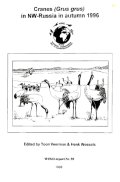 |
|
European Songbirds And Barn Swallows Hirundo rustica In Ghana: A Quest For Constant Effort Sites And Swallow Roosts In December/January 1996/97B. Van den Brink, R.G. Bijlsma & T.M. van der Have
WIWO Report 58
Working Group International Wader and Waterfowl Research
1998
"The main aim of this project was to develop operational Constant Effort Sites in wetland habitats in Ghana where moult, condition and survival of European wetland birds could be monitored, thus obtaining information about the condition of European passerines and Swallows wintering in Ghanaian wetlands."
|
 |
|
Breeding waders at Medusa Bay, western Taimyr, in 1996I. Tulp, L.W. Bruinzeel, J. Jukema & O. Stepanova
WIWO Report 57
Working Group International Waterbird and Wetland Research
1997
"In the summer of 1996 a Dutch expedition was undertaken to Medusa Bay, western Taimyr. The expedition period lasted from June 11 until July 25, the actual stay in the study area started on June 19 and ended on July 21. The studies undertaken included: monitoring of breeding bird densities in a defined area, recording breeding succes of waders, recording habitat preferences by means of tundra type mapping, recording seasonal abundance of arthropod fauna, trapping and ringing of adult waders, studying nest incubation schedules in Little Stints, recording body mass dynamics in Little Stints and Curlew Sandpipers and measuring energy expenditure of incubating Little stints using the doubly-labelled water method."
|
 |
|
European Swallows Hirundo rustica in BotswanaB. Van den Brink, R.G. Bijlsma & T.M. van der Have
WIWO Report 56
Working Group International Wader and Waterfowl Research
1997
"The objectives of the Botswana Swallow Project 1993-95 were:
to collect information about the origin of European Swallows 'wintering' in Botswana, especially those from The Netherlands and other parts of Western Europe (where the species is in serious decline); to assess the importance of Botswana as 'wintering' ground for European Swallows; to study environmental factors that influence moult and body condition of European Swallows 'wintering' in Botswana; to obtain information about site fidelity of Swallows to 'wintering' areas; to study differences in the timing of moult of adult and juvenile European Swallows; to count the number of waterbirds in wetlands used by European Swallows as roosting and foraging sites; to investigate possible threats to European Swallow roost sites."
|
 |
|
Breeding waders at Prochishcheva Lake, Northeastern Taimyr, Siberia, in 1991H. Schekkerman & M. van Roomen
WIWO Report 55
Working Group International Waterbird and Wetland Research
1995
|
 |
|
Waterbirds in Kneiss, Tunisia, February-March 1994T.M. van der Have, N. Baccetti, G.O. Keijl & M. Zenatello
WIWO Report 54
Working Group International Waterbird and Wetland Research
1997
|
 |
|
Birds Of The Messolonghi Wetlands. Eastern Mediterranean Wader Project, Spring 1990Editor: W.T. de Nobel
WIWO Report 53
Working Group International Waterbird and Wetland Research
1995
|
 |
|
Breeding birds of Cape Wastochnia, Pyasina Delta, Taimyr, Russia, in 1994Holmer Vonk
WIWO Report 52
Working Group International Waterbird and Wetland Research
2003
"As expected from observations made in earlier years, the breeding season of 1994 was a peak year in lemming densities. Lemmings normally show a three-year cycle in abundance. With the last peak year at Cape Wastochnia being 1991, this pattern also occurred in the study area. Arctic Fox was also present with one occupied burrow at the eastern border of the study plot. As a result of the lemming densities, the typical lemming predators Snowy Owl, Pomarine Skua and Rough-legged Buzzard were breeding in the area. The breeding of some species, at least White-fronted Goose, also seems restricted to lemming peak years in the area. Most non-predatory species also occurred in 1993. Breeding densities were comparable in both years. The density of lemmings thus not seems to influence the number of birds which start breeding. However, in this differences between methods and observers should be taken into account. Densities found in 1994 should be considered as the absolute minimum of the numbers actually present and might actually give some underestimation for the smaller wader species."
|
 |
|
Icelandic Black-tailed Godwit project 1993G.J. Gerritsen & N.M. Groen
WIWO Report 51
Working Group International Waterbird and Wetland Research
1995
|
 |
|
Wintering Geese in Turkey, January 1992Lieuwe J. Dijksen and Michel C.M. Klemann
WIWO Report 50
Working Group International Wader and Waterfowl Research
1994
|
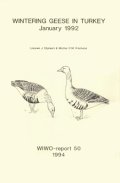 |
|
Wintering waterbirds in the coastal wetlands of Albania, 1993Editor: W.J.M. Hagemeijer
WIWO Report 49
Working Group International Waterbird and Wetland Research
1994
|
 |
|
Wader and waterfowl migration in the Çukurova deltas, South Turkey, spring 1990Editor: H.A. Kivit, H. Nijmeijer & A. Ovaa
WIWO Report 48
Working Group International Waterbird and Wetland Research
1994
|
 |
|
Waders and waterbirds along part of the Atlantic coast of Morocco, autumn 1991 - spring 1992Editor: N.M. Groen & P.J. Zomerdijk
WIWO Report 47
Working Group International Waterbird and Wetland Research
1994
|
 |
|
Ornithological survey of the coast of Libya, July 1993P.L. Meininger, P.A. Wolf, D.A. Hadoud & M.F.A. Essghaier
WIWO Report 46
Working Group International Waterbird and Wetland Research
1994
|
 |
|
Bird census in the Kizilirmak delta, Turkey, in spring 1992Editor: F. Hustings & van Dijk K.
WIWO Report 45
Working Group International Waterbird and Wetland Research
1993
|
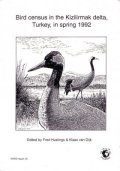 |
|
Wader ringing in Tun1sia 1962-1986H. Spiekman
WIWO Report 44
Working Group International Waterbird and Wetland Research
1992
|
 |
|
Bird observations in the Danube delta and in the Dobrodgea (Romania)S. Brehme, T. Müller & J. Redlich
WIWO Report 43
Working Group International Waterbird and Wetland Research
1992
|
 |
|
Bahrain wader study 1991E. Hirschfeld, S.A. Mohamed & T. Stawarczyk
WIWO Report 42
Working Group International Waterbird and Wetland Research
1992
|
 |
|
Coastal waterbirds in GabonEditor: F.J. Schepers & E.C.L. Marteijn
WIWO Report 41
Working Group International Waterbird and Wetland Research
1993
|
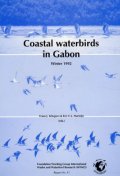 |
|
Ornithological studies in Egyptian wetlands 1989/90. FORE-report 94.01Editor: P.L. Meininger & G.A.M. Atta
WIWO Report 40
Working Group International Waterbird and Wetland Research
1994
|
 |
|
Waders in Guinea-Bissau, October 1992-May1993 The end of the East Atlantic FlywayEditor: W.J. Wolff
WIWO Report 39
Working Group International Waterbird and Wetland Research
1998
|
 |
|
Waterbirds in the Kneiss area and other wetlands, Tunisia. Eastern Mediterranean Wader Project, spring 1990Editor: H.W. Spiekman, G.O. Keijl & P.S. Ruiters
WIWO Report 38
Working Group International Waterbird and Wetland Research
1993
|
 |
|
Mid-winter waterfowl census Turkey January 1990L.J. Dijksen & A-M. Blomert
WIWO Report 37
Working Group International Waterbird and Wetland Research
1993
|
 |
|
Waterbirds in the Sivash, Ukraine, spring 1992Editor: T.M. van der Have, S. van der Sant, Y. Verkuil & J. van der Winden
WIWO Report 36
Working Group International Waterbird and Wetland Research
1994
|
 |
|
Ornithological importance of coastal wetlands in Guinea. Joint report of WIWO and ICBP. WIWO-report 35 and ICBP study report nr. 47W. Altenburg & J. van der Kamp
WIWO Report 35
Working Group International Waterbird and Wetland Research
1991
|
 |
|
Waterbirds in the Van Province, eastern Turkey, May 1989V.M. van den Berk, J.P. Cronau & T.M. van der Have
WIWO Report 34
Working Group International Waterbird and Wetland Research
1993
|
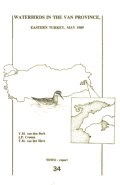 |
|
Survey of breeding waders and relations between breeding performance and lemming densities, North-East Taimyr, Siberia, 1992H. Spiekman & N. Groen
WIWO Report 33
Working Group International Waterbird and Wetland Research
1993
|
 |
|
Migration of waterbirds through wetlands in Central Anatolia, spring 1988Editor: H. Schekkerman & M.W.J. van Roomen
WIWO Report 32
Working Group International Waterbird and Wetland Research
1993
|
 |
|
Mid-winter waterfowl census Turkey January 1989L.J. Dijksen & A-M. Blomert
WIWO Report 31
Working Group International Waterbird and Wetland Research
1989
|
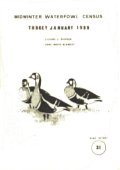 |
|
Migration of waders and other waterbirds along the Mediterranean coast of Israel, spring 1989G.O. Keijl, M.W.J. van Roomen, P.S. Ruiters & A. Wijker
WIWO Report 30
Working Group International Waterbird and Wetland Research
1992
|
 |
|
Moroccan Slender-billed Curlew survey, winter 1987-88A.B. van den Berg
WIWO Report 29
Working Group International Waterbird and Wetland Research
1988
|
 |
|
Waders and waterfowl in spring 1988 at Eber Gölü, TurkeyA. van Winden, K. Mostert, P. Ruiters, M. Siki & H. de Waard
WIWO Report 28
Working Group International Waterbird and Wetland Research
1989
|
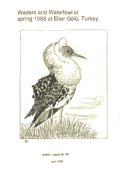 |
|
Homeward bound: Problems waders face when migrating from the Banc d'Arguin, Mauritania, to their northern breeding grounds in springB.J. Ens, T. Piersma, W.J. Wolff & L. Zwarts
WIWO Report 27
Working Group International Waterbird and Wetland Research
1990
|
 |
|
Ornithological importance of the coastal wetlands of Guinea-BissauW. Altenburg, E. Wymenga & L. Zwarts
WIWO Report 26
Working Group International Waterbird and Wetland Research
1992
|
 |
|
Report of the Dutch-Mauritanian project Banc d'Arguin 85/86. Joint report of WIWO and RIN nr. 25Editor: B.J. Ens, T. Piersma, W.J. Wolff, L. Zwarts
WIWO Report 25
Working Group International Waterbird and Wetland Research
1989
|
 |
|
Les zones humides dans la region de Anaba et El Kala en Mai 1987B. Chalabi & G. van Dijk
WIWO Report 24
Working Group International Waterbird and Wetland Research
1988
|
 |
|
Etude ornithologique préliminaire de la zone côtière du nord-ouest de la Guinée. Joint report of WIWO and ICBP. WIWO-report 23 and ACBP study report 30W. Altenburg & J. van der Kamp
WIWO Report 23
Working Group International Waterbird and Wetland Research
1989
|
 |
|
South Turkey Project. A survey of waders and waterfowl in the Çukurova deltas, spring 1987Editor: T. van der Have, V.M. van den Berk, J.P. Cronau & M.J. Langeveld
WIWO Report 22
Working Group International Waterbird and Wetland Research
1988
|
 |
|
Mid-winter waterfowl census Turkey, January 1988L.J. Dijksen & A-M.C. blomert
WIWO Report 21
Working Group International Waterbird and Wetland Research
1988
|
 |
|
Birds of the wetlands in North-East Greece, spring 1987
Editor: P.L. Meininger
WIWO Report 20
Working Group International Waterbird and Wetland Research
1990
|
 |
|
Notes on the birds of some wetlands in North-East Greece and Turkey
R. Lensink
WIWO Report 19
Working Group International Waterbird and Wetland Research
1987
|
 |
|
Mid-winter waterfowl census Turkey January 1987L.J. Dijksen & P. van der Wolf
WIWO Report 18
Working Group International Waterbird and Wetland Research
1987
|
 |
|
An ornithological winter survey of Lake Turkana, KenyaH. Schekkerman & J.C.J. van Wetten
WIWO Report 17
Working Group International Waterbird and Wetland Research
1987
|
 |
|
Survey of waterbirds on Egyptian wetlands, autumn 1981C.A. Bennet, R.G. Bijlsma & R. Stouthamer
WIWO Report 16
Working Group International Waterbird and Wetland Research
1982
|
 |
|
Waterfowl in West African coastal wetlands: a summary of current knowledgeW. Altenburg
WIWO Report 15
Working Group International Waterbird and Wetland Research
1987
|
 |
|
Observations of waterbirds in some wetlands in Turkey, July/August 1986L. Schilperoord & M. Schilperoord-Huisman
WIWO Report 14
Working Group International Waterbird and Wetland Research
1986
|
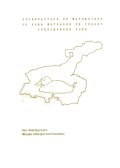 |
|
Mid-winter waterfowl census, Turkey 1986L.J. Dijksen & F.J. Koning
WIWO Report 13
Working Group International Waterbird and Wetland Research
1986
|
 |
|
Notes on the birds of some wetlands in TurkeyR.G. Bijlsma & F.E. de Roder
WIWO Report 12
Working Group International Waterbird and Wetland Research
1986
|
 |
|
Wintering waders and waterfowl in the Gulf of Gabès, Tunisia, January-March 1984A.J. van Dijk, K. van Dijk, L. Dijksen, T. van Spanje & E. Wymenga
WIWO Report 11
Working Group International Waterbird and Wetland Research
1986
|
 |
|
Cranes and waterfowl counts of some Turkish wetlandsV. van den Berk, D. van Dorp, O. van Hoorn & R. Vos
WIWO Report 10
Working Group International Waterbird and Wetland Research
1986
|
 |
|
Entre Sahara et Siberie. Ewijk, The NetherlandsB. Ens
WIWO Report 9
Working Group International Waterbird and Wetland Research
1985
|
 |
|
Les zones humides du Nord-Est Algerien en 1984B. Chalabi, J. Harrison & G. van Dijk
WIWO Report 8
Working Group International Waterbird and Wetland Research
1985
|
 |
|
Wader studies and waterbirds in the Nakdong Estuary, South Korea, in September 1984T. Piersma
WIWO Report 7
Working Group International Waterbird and Wetland Research
1985
|
 |
|
The importance of some wetlands in Turkey for transient and wintering birds in TurkeyV. Van den Berk, N. van den Berk, R.G. Bijlsma & F.E. de Roder
WIWO Report 6
Working Group International Waterbird and Wetland Research
1985
|
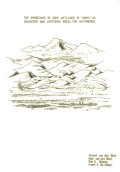 |
|
Waterbirds on som Turkish wetlands, October/November 1983F.E. De Roder
WIWO Report 5
Working Group International Waterbird and Wetland Research
1985
|
 |
|
Waders along the coast of Thailand during November and December 1984R.G. Bijlsma & F.E. de Roder
WIWO Report 4
Working Group International Waterbird and Wetland Research
1985
|
 |
|
Water birds at some wetlands in Turkey and GreeceJ. Philippona
WIWO Report 3
Working Group International Waterbird and Wetland Research
1985
|
 |
|
Wader migration along the Atlantic coast of Morocco, March 1981M. Kersten, T. Piersma, C. Smit & P. Zegers
WIWO Report 2
Working Group International Waterbird and Wetland Research
1983
|
 |
|
Wintering waders at the Banc d'Arguin, Mauritania. W. Altenburg, M. Engelmoer, R. Mes & T. Piersma
WIWO Report 1
Working Group International Waterbird and Wetland Research
1982
|
 |
|